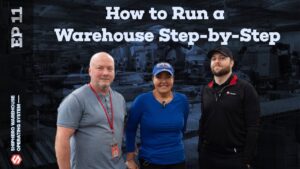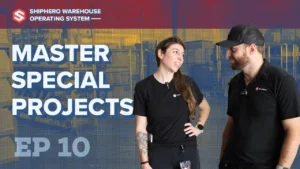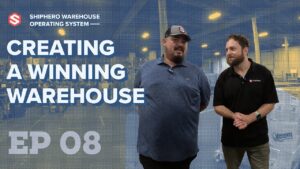Returns Processing Walkthrough
Video Transcript
Hello everyone and welcome to another episode of ShipHero Future Walkthroughs. I'm joined today by Yosef, our ShipHero VP of Product. How are you?
Good, how are you doing?
Awesome, happy to have you here. So today Yosef will walk us through an interesting ShipHero feature: returns processing. Please take it away.
0:28
Thank you. So yeah, today we're gonna take a look at how you process returns in ShipHero. We're gonna focus on what happens when a return comes back into the warehouse. I'm not gonna look at how you create the returns. Returns can be created a number of ways in ShipHero including manually in the ShipHero admin, using our customer self-service returns API. We also have some integrations with companies like Loop Returns or internally. But we're gonna take a look at what happens after a return is created and you actually get the merchandise back in the warehouse.
1:00
So as you can see on my screen, I have the ShipHero returns section pulled up, and that's just under Returns > All Returns. It's showing me the returns that have been created. Now you can use this to search as well, so if you have a return that comes back, you can search by the RMA number that was assigned, the order number, or even the tracking number. To process the return, I'm going to click into the return detail.
1:31
You can see we have all the return information here. Starting from the top, you can see the details: when the return was created. You can view the actual return label if you need to, or you can void it. On the right side, you can see the actual information for the package: the tracking number, the cost of that label, and the weight and dimensions as well.
1:57
Below that is the actual item on the return. So in this case, just one item, and it tells us how many we're expecting. So we're expecting the customer to send one back. We haven't received any, so previously received is zero. And then I could put in how many I received now. The receipt quantity is just for recording purposes. That's not going to change what is actually returned, but if you want to record that you actually got the return, you can record that there. So I'll put a one there. And then looking after restocked, that's how I would actually put the inventory back into my ShipHero inventory. Now if it's damaged or you're not reselling the product, you just leave that at zero and restock won't have any effect if you are adding something back into inventory. So I'll put a one there.
2:42
You can also tell us where you want to put that. Now we'll show you the bins associated with that product. In this case, there's just one bin that has that product, but if there were multiple bins with that product, we would list them all there. You could choose. We can search for any bin. One common thing we see is customers having specific bins for returns. So in this case, let's say I have my return bin, start typing and click on that result. And I could use that to stage the return. So this example, that return's bin is a non-sellable bin. So before I'm able to inspect it to make sure that I want to resell it, I put it in that non-sellable bin, and if it is good to resell, I would then transfer it from the non-sellable bin to one of my bins on my shelf.
3:27
So I set up my return, I put in how many came back, and then I could save that. Now one note on status: we have these statuses here, so pending, warehouse complete, and complete. Those are just to manage your return process. Some things we see customers do is have warehouse get the return inspected and check it back, check it in, and then set it to warehouse complete. And that might tell someone in the office, for example, that they need to look at that and maybe issue a refund, for example. So you can create your own return statuses if you have a different workflow, but these are the three default ones that we have. So in this case, you can see I put it to warehouse complete, saved it, and it's updated that return, that inventory has now gone to my return bin. You can see those previously received and previously restocked are now updated because I saved that return.
4:20
Going down the page a little bit, you can see I have a section for attachments. That's great if you want to take a picture of the item if somebody's damaged, you want to record that and take that picture and attach it to the return so you can reference it later.
4:33
Below that is a section for refund. So the refund itself, if it's a Shopify order, we can't actually trigger that refund directly in Shopify. Shopify does have the ability to actually tell us what the return should be taking into account things like taxes. So there is a calculated Shopify refund button, and that will use Shopify's API to calculate what the refund should be based on what was returned. Otherwise, you can enter in this information here to get a total refund. So once you have your total refund amount, you can hit refund and we'll issue that refund through Shopify. If it's not a Shopify order or you issue the refund outside of ShipHero, you just hit mark as complete and that'll mark the return as complete.
5:51
For that, we do have a history, so anything that happened on the return when it was returned, when it was generated, will be logged in the history.
6:00
One other thing to look at would be an exchange. An exchange is something that if you're creating the return within ShipHero, you can actually create an exchange order at the same time. So if you have done that, you'll see on the return detail page you have a section for exchanges. So you can see this return had an exchange associated with it, and at this point, I can release the exchange, which would then allow that exchange order to go out. So by default, when you create an exchange, that's on hold essentially and won't go out until you release it. So once that return comes back, you can release the exchange and that will allow that exchange order to go out. The rest of the process is the same; there's no refund. You can just skip that section. But in terms of actually bringing the inventory back in, that's the same as we saw before. And that's it. That's a quick overview of the return process in ShipHero. Hope you learned something. Thank you very much, Yosef. That was very insightful.
6:58
And if you'd like to check out other feature walkthroughs, click on the top right corner. And if you're ready to unlock your eCommerce fulfillment superpowers, visit shiphero.com to schedule a call with us. Thank you for watching and have a great day.



